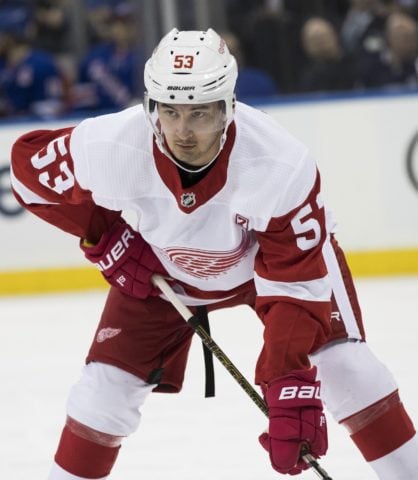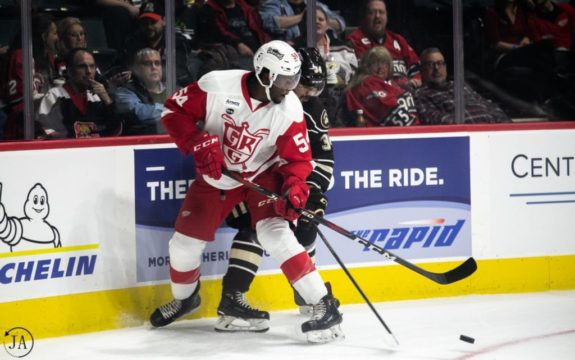Over the course of a rebuild, many players will have their moment in the limelight. But, whether you like it or or not, no player is guaranteed a spot in the NHL. Despite the promise they may show in a given moment, it simply does not mean that a roster spot will be available to them the next day. Look no further than the roster of the Grand Rapids Griffins, the Detroit Red Wings’ AHL affiliate. Guys like Joe Hicketts, Evgeny Svechnikov and others have all made a case to stay in Detroit at least once, and yet they find themselves stuck in the lower league.
That is not the case with forwards Taro Hirose and Givani Smith, both of whom are currently part of the Red Wings’ team in some fashion. Smith, the 46th pick of the 2016 draft, bounces back and forth between the taxi squad and roster, mostly as a cap-saving precaution, but has seen eight games of action this season. Hirose, who the Red Wings signed as a college free agent out of Michigan State University back in the spring of 2019, was sent to the taxi squad on February 4 and has not seen any game action since then. He has played six games this season.
Both players were stand-outs from training camp, which is what helped them land a taxi squad spot to begin the season. Since then, both players have done enough to warrant more NHL action going forward. While they play very different games, both of them provide skills and assets that the rest of the Red Wings’ roster could greatly benefit from. But don’t just take my word for it, let their results do the talking.
Givani Smith
Smith has been nothing short of a lightning rod for his team since entering the lineup. In his eight games of action, he has accumulated four points, already besting his total over 21 games last season. To cap it off, he put on a show against the Florida Panthers on February 7 when he completed the legendary trio of a goal, an assist and a fight: the Gordie Howe hat trick.
Among skaters to play at least eight games for the Red Wings this season, Smith sits seventh on the team with a shots-for percentage (SF%) of 49.4 percent at even strength (SF% determines the share of shots a player’s team has while that player is on the ice.) He creates opportunities for his teammates through his willingness to do the dirty world along the walls and his ability to create space via his physicality. This is the reason why head coach Jeff Blashill has used the soon-to-be 23-year-old on the top line alongside team captain Dylan Larkin and 2018 top pick Filip Zadina.
While he averages just under 10 minutes of ice time a game so far this season, you can almost always tell when he’s on the ice. The puck isn’t always heading in the right direction, unfortunately, but things are happening; his abrasive style of game stands out when the ice is entirely occupied by skill players and slow veterans. He’s a modern-day grinder that has the youth to throw his body around without (much) risk of serious injury.
The other important thing to note is the work that Smith has put into his game to bring him to this point. It seems that every note the coaching staff gives him, he takes in and immediately goes to work on it. His defensive game isn’t perfect, but he’s brought it a long way. His skating isn’t effortless like Larkin’s, but he’s able to keep up with the pace. He even seems to have found out how to translate the offensive side of his game to the NHL level. If you’re trying to preach to your young players that hard work pays off, then you have to reward players like this that embrace the challenge and go to work.
Taro Hirose
For Hirose, the numbers match the eye test. Not only is it clear that he provides excellent vision on the ice, which lead to several solid shifts on the power play during his six games, but it’s also clear that he generally helps push the play in the right direction when he’s on the ice. If you’re not convinced, I’ve got some numbers for you:

Hirose leads the team with a goals-for percentage (GF%) of 75. With him on the ice, the Red Wings have scored three times and have only allowed one. His high-danger Corsi-for percentage (HDCF%) is a spectacular 57.9, meaning that the Red Wings get 57.9 percent of the high-danger chances while he is on the ice. As for his relative-Corsi rate – a measurement of the direct impact a player has on his team’s share of offensive chances – he has a solid 4.6 mark, meaning he increases Detroit’s offensive chances by 4.6 percent (at all strengths). Despite the fact that he has just two assists through six games, the numbers don’t lie: this kid can play.
What’s even more baffling about Hirose’s exclusion from the roster at this point is the clear benefit he brings to the power play. Given that the Red Wings have converted on just 8.5 percent of their total power plays thus far, you would think that the coaching staff would be looking for someone that can provide a jolt for what has been a pretty unexciting power play through 15 games. Though he did not register a point on the power play during his time on the roster this season, his ability to move the puck and find passing lanes immediately made the power play look much more dangerous. It’s those crisp, creative passes that are sorely missing from Detroit’s power play. I’ve even gone as far as to say that he should be running the point on the man-advantage instead of Filip Hronek and others.
Long-Term Impact
The Red Wings currently have half of their roster filled with veteran players that are yielding mixed results. While it makes sense to play these older players as a way to showcase them for a potential trade, there has to come a time when the coach and the rest of the decision-makers recognize that stunting a player’s growth is not worth the fourth round pick you might get from trading Sam Gagner (and he’s not even a player that I would replace with Hirose or Smith.) If a player improves your team, regardless of their age or their status in the league, this crazy season is the perfect stage to set them loose and see what they can do.

With the Seattle Kraken expansion draft looming at the end of the season, it also helps to know what players are worth protecting, and which ones you can afford to expose. Both Smith and Hirose could prove to be savvy pick-ups by Seattle general manager Ron Francis if the Red Wings opt to expose them. The Red Wings should look at this as an excuse to get both players some steady playing time to see if they’re for real or not. If they’re not, no harm, no foul – at least you now know for sure and can move on to the up and comer.
The bottom line is that the Red Wings’ benchmark for success this season is simply to see legitimate improvement. Wins and losses aren’t the best measurement of success for this team; it’s about whether or not they’re staying alive for 60 minutes game-in and game-out, and their young players aren’t regressing or stagnating. There are very few excuses to do anything that would prevent this team from further improvement.
In a season where improvement was set as the ultimate goal, it’s time to improve the roster by inserting and keeping Hirose and Smith in the lineup.
Stats from Natural Stat Trick
Want more Red Wings content? Tune into The Hockey Writers’ Grind Line — a new weekly live show on YouTube and Facebook. We stream Friday nights starting at 8:30 pm ET on The Hockey Writers YouTube channel. Check out this week’s show below, and make sure you subscribe to the channel so you don’t miss any upcoming shows.